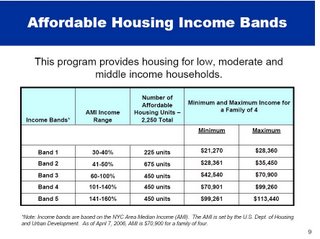 Charles Gargano, chairman of the Empire State Development Corporation (ESDC), long ago abandoned any pretense of objectively evaluating the Atlantic Yards plan, telling the New York Observer in December that "“There is no need to scale down the project,” even though it was months before the environmental review would be launched.
Charles Gargano, chairman of the Empire State Development Corporation (ESDC), long ago abandoned any pretense of objectively evaluating the Atlantic Yards plan, telling the New York Observer in December that "“There is no need to scale down the project,” even though it was months before the environmental review would be launched. Ten months later, he remains disturbingly misleading regarding basic questions about the project, confidently declaring that eminent domain will not be used and waving off questions about process and transparency. And if the p.r. process demands it, he can easily reverse himself, telling his interviewer, "We have been working with the developers to lower the size of the project."
Those comments come in an interview Gargano did for the New York Voices documentary, Ratner's Brooklyn Redevelopment Plan, scheduled to run tonight on Ch. 13 at 10:30 pm. Others to be interviewed include City Council Member Letitia James, a project opponent, and Daniel Goldstein and Shabnam Merchant, the spokesman for and a fellow leader of Develop Don't Destroy Brooklyn, the coalition opposing the project.
A source sent me a transcript of those comments. (I can't be sure if they're exact, but I'll tape it tonight and make any corrections if necessary.)
Overwhelming scale
Gargano was first asked about the project's scale.
Q: If the Atlantic Yards Project is approved, as it now stands, it would create 16 very tall buildings, one of which will be over 600 feet tall... Some critics say that this will dwarf the neighborhood. What do you say?
Gargano: Well I think, you know, New York City in general is a city of skyscrapers. We've had plenty in Manhattan. We have had some in other boroughs. We had the Williamsburg Savings Bank that I remember from when I was a little boy growing up in Park Slope Brooklyn. I don't think that was obscene in any way. Look, all of these things, we cannot stop progress, stop development. I think what we have to do is to make sure we go through the proper process to assess everything, from an environmental point of view, from a traffic point of view, from every aspect of it-which we are doing. That's the important thing. It doesn't matter whether it is two buildings or 10 buildings. There's always going to be more buildings built in New York City. Thank God.
The proper process includes some effort to assess the scale of the development. As the Municipal Art Society has pointed out, the project would equal 23 Williamsburgh Savings Banks. The New York Observer's Matthew Schuerman yesterday delineated how he calculated that Atlantic Yards would be twice as dense as the densest census tract in the country.
In comments submitted by the Council of Brooklyn Neighborhoods in response to the Draft Environmental Impact Statement (DEIS), Ethan Cohen of the City College Architectural Center observed, "The sheer size of the project makes it inherently incompatible with the City's approach to upzoning other districts to promote new development."
And, of course, there's a widespread belief, not just from critics who responded to the DEIS but even from Borough President Marty Markowitz, that the "proper process" hasn't yielded legitimate solutions to looming traffic and transit bottlenecks.
Affordable housing
 Q: If this project goes through, many of the affordable housing units are slated to go to families with a household income of between $70,000 and $113,000. In what respect can we consider those households families of limited means?
Q: If this project goes through, many of the affordable housing units are slated to go to families with a household income of between $70,000 and $113,000. In what respect can we consider those households families of limited means?Gargano evaded the question.
A: All I can tell you is that this project, and we have insisted on that from the very beginning, and a developer has been extremely cooperative, of more than 6,000 apartments, 2,250 will be affordable housing. And also in addition to that, we have since the project will be staged, a portion will be completed by 2010, along with the arena, the basketball arena, we want to be sure that many of these affordable housing units are built first. And the developer has agreed to that.
Many = 550 of 2250. Unmenioned is that there are no guarantees of when or if Phase 2 would be built. Or that the developer originally promoted the plan as including 900 apartments for moderate-income households, earning between $42,500 and $70,900, rather than 450 units as now promised.
But host Rafael Pi Roman followed up.
 Q: Would you consider these homes that build between $70,000 to $113,000 affordable housing units?
Q: Would you consider these homes that build between $70,000 to $113,000 affordable housing units?A: Well first of all, affordable housing, that's a question of what the market is. It has to be measured by the market. Where affordable housing levels are, where market levels are. This is what determines what's affordable and what's market.
That's a highly inadequate answer. Affordable housing is, simply, housing that costs 30% of household income. And yes, there can be affordable housing for families earning at or above the Area Median Income (AMI) of $70,000, but the question is how much. The number of units geared to particular income groups depends on subsidies and other costs, not the market. And we don't even know what the housing subsidies would be.
In the Atlantic Yards plan, there would be five bands--from 30% to 160% of AMI. Note that the New York AMI, because it includes prosperous suburban counties, is about twice Brooklyn's median income. Hence the effort by some groups to have the Atlantic Yards affordable housing better serve Brooklynites. The Greenpoint-Williamsburg rezoning, in fact, extended the bands to below 30% of AMI.
Households at Brooklyn's median income would be eligible for only 40% of the affordable housing.
No eminent domain?
Forest City Ratner owns or controls some 90% of the land needed, but as I've reported, that understates the need to negotiate with tenants or gain their property via eminent domain.
Q: Are you willing to declare eminent domain and push them off the territory?
A: We are not using eminent domain at this point in time. I believe there was one instance where we might have, it wasn't necessary. It was in done in a [friendly] condemnation. We will look at that at the appropriate time. Right now it is not our intention to use eminent domain. It is our intention to work this out with those families and let them know that this new project will be very good for them in terms of what will be available to them on an affordable level rent rate.
(Emphasis added)
However, the ESDC plans to use eminent domain, via "friendly condemnations," on the property in the footprint owned by the developer, and also for those property owners who've refused to sell. Not all of those property owners are families that would need a new place to live; some are business owners who don't like having to negotiate under the threat of eminent domain.
Doesn't Gargano read his agency's own documents? See p. 4 of the public hearing notice:
The following is a list of the specific parcels that would be acquired by eminent domain, which list includes parcels owned by the City, Forest City Ratner Companies (“FCRC”) or its affiliates, or unrelated private third parties.
(Emphasis added)
Gargano's time sequencing is again confusing.
ESDC objectivity
Q: Now Mr. Gargano, the Empire State Development Corporation, which you chair, is the entity that will have to decide whether or not to approve the Atlantic Yards Project. As we have seen, you are a supporter of this project. So the question has to be asked, is there really a chance that the Empire State Development Corporation won't approve the development of the Atlantic Yards?
A: Well let me tell you the process here. You know, I don't think it is fair to try and categorize this as a project that we want and we just want to get this over. We have been working with the developers to lower the size of the project. Now the project has been reduced by 8%. And we are constantly, we talked to the developer about increasing the size of the park, the amenity. We are doing all of this all of the time... We work for a common ground, something that the developer can live with and not walk away from a project and say well too bad, we can't do it; the public sector doesn't want to be a partner with us. That's what happened 50 years ago with the Brooklyn Dodgers.
The reduction, it must be noted, would bring the project back to the same square footage as originally announced. An increase of one acre of open space still would leave far too little for the vast new population, and the open space wouldn't arrive until after Phase 2, which isn't guaranteed. Given the extremely valuable site at issue, is the state really at such a disadvantage?
Time frame
Q: And where is the process now?
A: The process now, we have completed our public forums, our hearings... Now we are reviewing all of the comments, all the concerns, and we are trying to address all of them. When we are satisfied that they have been addressed, and the staff and consultants are all working on this, all different types of experts. Once that is accomplished, it will then come back to the Empire State Development Board of Directors for approval, affirmation once again. But there is still a process to go through.
Will the ESDC require a Supplemental Environmental Impact Statement to respond to flaws in the DEIS, as several groups have requested? Or will the agency do its best to rush the project through approval so it can be signed off by outgoing Gov. George Pataki, who supported it?
Missing fiscal impact analysis
Q: Some individuals--lawyers, some journalists--want to know exactly how you came up with the figures, of the gains and losses, and they've even filed under the Freedom of Information act, but the [ESDC} has refused...
A: Well first of all, what they are looking for is internal documents, working documents... Completed documents, once the project is approved, once we have completed the negotiations with the developers, they will all be public record. So we are now still negotiating and when you are negotiating you don't open your cards up to who you are negotiating with... I mean that's simple business. Now it is not a question of not wanting to make documents available. When they are completed, when the deal is done, then the documents will be public record.
That's nonsense. The fiscal impact analysis is based on the project as it was presented, and the ESDC was eager to promote the net gain, $1.4 billion, without explaining how it was derived. The Independent Budget Office released its analysis. The New York City Economic Development Corporation did so as well. And so did Forest City Ratner's own consultant, Andrew Zimbalist.
Yes, Develop Don't Destroy Brooklyn asked for the documents, but I and fellow journalist Neil de Mause did so as well. Community Board 2 noted the lack of transparency. And the Council of Brooklyn Neighborhoods pointed out that the DEIS "fails to disclose public costs."
Any journalist attempting to report on this topic in any detail should be asking the same question. Maybe Assemblyman Jim Brennan will have better luck in gaining this fundamental piece of information.
Comments
Post a Comment